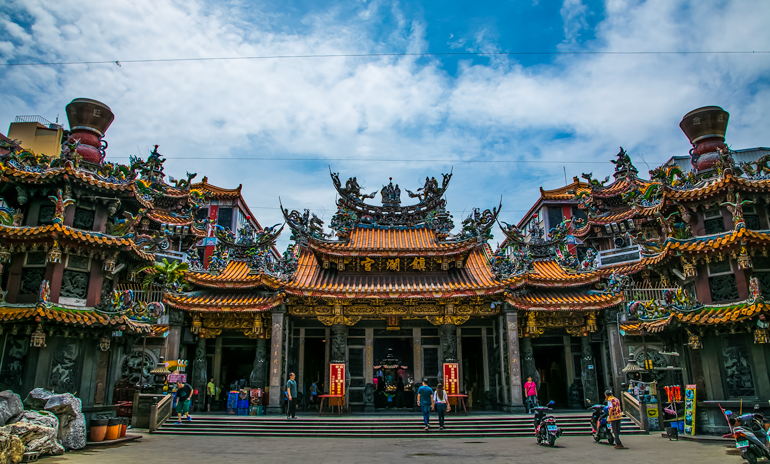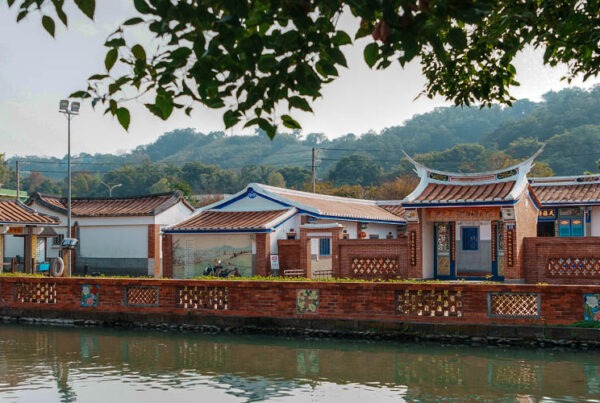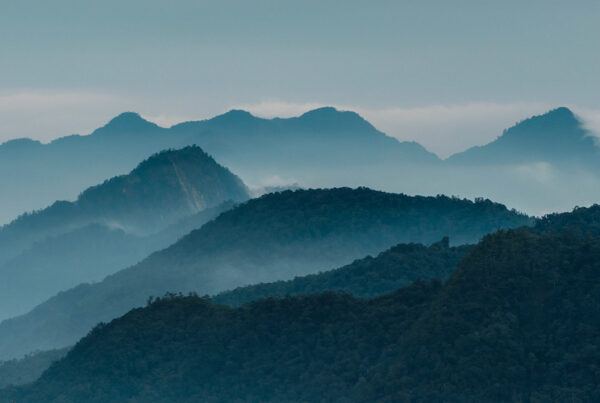Old Neighborhoods and Windy Wetlands — Taking the Coastal Railway Line in Central Taiwan
Text: Steven Crook; Photos: Vision
Situated between the modern downtown core of Taichung City and the Taiwan Strait are a number of districts worth exploring. Wander through old neighborhoods with narrow streets and busy temples, head to the coast for views of windswept wetlands, feast on fresh seafood at a fish market, and learn about local history at well-preserved heritage sites.
Taichung is now Taiwan’s second-most-populous municipality. With 2.79 million residents, it has overtaken both Taipei City and the southern harbor city of Kaohsiung. Only New Taipei City, an agglomeration of rural and urban districts that surrounds the capital, has more residents.
Coastal area of Taichung
To meet the travel needs of denizens and visitors in this fast-growing metropolis, Taichung’s transportation infrastructure is being upgraded. The Taichung Metro, due to begin operations by the end of 2018, will have 18 stations along its initial Green Line. A light-rail link between Taichung Airport and the southern suburb of Wufeng is planned. But for this issue of Travel in Taiwan, we’ll be making good use of a much older transportation system: the Coastal Line operated by the Taiwan Railways Administration (TRA) since 1922.
Because trains on the Taiwan High Speed Rail (THSR) system are much faster than conventional trains, fewer people now use TRA trains to get from the north of the island to the south. But travelers shouldn’t ignore the conventional railway network. With more than 150 stations on the western half of the island (the THSR has just 12), the TRA can deliver you to within walking distance of a great many attractions.
The Coastal Line runs through Miaoli County, Taichung City, and Changhua County, and for most of its 90.2km it stays within 5km of the Taiwan Strait. The northern section from Zhunan to Yuanli was covered in this post: taiwaneverything.cc/2017/07/05/miaoli-coast-railway/. The southern section, which lies almost entirely within Taichung City, begins at Rinan in Taichung and ends at Changhua Railway Station in Changhua County.

Train on the coastal line in Miaoli
Rinan
The main attraction at Rinan is the 96-year-old station itself, a creamy-yellow asymmetrical delight made largely of wood. Not surprisingly, it has become a popular venue for pre-wedding photography sessions, a popular Taiwanese custom.
Dajia
With the exception of railway enthusiasts, few non-locals know anything about Rinan. However, the bulk of Taiwan’s population can tell you this, at least, about the next stop south: Dajia is the location of one of Taiwan’s busiest and most famous religious sites, Dajia Jenn Lann Temple. Founded in 1732, this shrine is widely regarded as the most important center of Mazu worship in Taiwan. Mazu, the Goddess of the Sea, is the most revered deity in Taiwan.

Dajia Jenn Lann Temple

Inside the temple
The temple, a five-minute stroll from Dajia Railway Station, is also where an annual multi-day pilgrimage in honor of Mazu’s birthday begins and ends each spring. The celebration, promoted in recent years as the key attraction in the Taichung Mazu International Festival, is said to be the largest annual religious event in the world outside India and the Middle East. Whatever time of year you visit, inside the temple you’ll see spirit money stacked almost to the ceiling, tables creaking under the weight of offerings, and a non-stop flow of Mazu believers offering prayers and incense. Some of the temple’s greatest treasures, among them Mazu icons made of solid gold and jade, are displayed in a basement annex.
Add: No. 158, Shuntian Rd., Dajia Dist., Taichung City
(台中市大甲區順天路158號)
Tel: (04) 2676-3522
Website: www.dajiamazu.org.tw (Chinese)
No amount of such bustle and color can stop your stomach from rumbling when chow time arrives, however, so you’ll likely want to explore the food options nearby. Fortunately there are a great many: Dajia Jenn Lann Temple draws thousands of visitors per day, and this is Taiwan, where the number of local eateries and street vendors invariably mirrors the amount of foot and vehicle traffic.
A good place to try is Dajia Ma Mianxian, a short walk from the temple, where the most popular dishes are vermicelli in a thick soup with oysters and gooey omelets featuring oysters or shrimp. All three items are priced NT$60 each. The vermicelli, in particular, slides down easily; because the noodles are so fine, and are chopped into short sections, chopsticks are redundant. Grab a spoon and dig in.

Dajia Ma Mianxian eatery

Vermicelli with oysters and intestines and oyster omelet
Add: No. 127, Jianggong Rd., Dajia Dist., Taichung City
(台中市大甲區蔣公路127號)
Tel: (04) 2686-4718
Taichung Port
Continuing south along the Coastal Line, there’s little point getting off the train at the next stop, as Taichung Port Railway Station doesn’t get you near either of the two main seaside attractions in this corner of Taichung.
One of these is Wuqi Fishing Harbor and its popular fish market. Taiwanese gourmands don’t expect seafood to always come to them. They’re willing to go to it, happily driving an hour or more to places like this because they believe they can get fresher produce and better deals at no-frills harborside restaurants than in downtown establishments.

Wuqi Fishing Harbor

Fish market
The other is the Gaomei Wetlands, a birdwatchers’ paradise during late fall and winter and a splendid location for enjoying sunsets throughout the year. To get to the wetlands, get off at Qingshui Railway Station and take bus no. 178 or 179 via the district of Qingshui’s bustling Zhongshan Road. Bus no. 111 connects the station with the wetlands and with Wuqi Fishing Harbor as well. If you want to get there from downtown Taichung, bus no. 309 runs every 25 minutes to the wetlands, starting from Taichung Railway Station, and the route terminates at the fish market.

Gaomei Wetlands boardwalk

Wetland crab
Qingshui
Not far from Qingshui Railway Station are a number of sights you can explore, either on foot or by renting a YouBike public bicycle (www.youbike.com.tw). The YouBike station closest to the railway station is at Qingshui School Japanese-Era Dormitories, adjacent to the town’s main elementary school (No. 59, Zhennan Street). Built between 1934 and 1940, and thoroughly restored in recent years, these single-story dormitories are a picture of classical Japanese elegance; think sliding doors, paper partitions, and polished wooden floors. They now serve as rehearsal spaces and meeting rooms for the school.
From there, head east along Zhennan Road, cross Zhongshan Road, and turn left onto Dajie Road. Look for a broad path leading uphill just before Dajie intersects with Wenchang Street. This path leads to the intriguing Niumatou Cultural Park, where traces of Taiwan’s Neolithic Period inhabitants have been discovered. Also at this site is what little remains of a Shinto shrine constructed during the Japanese colonial era. The park is open 9am to 5.30pm every day but Monday.

Niumatou Cultural Park

Archaeological site
Outdoor types will certainly want to continue on and up to the nearby Aofeng Jade Bridge and Aofeng Hill Viewing Platform. The former is a pedestrian bridge over a spillway designed to drain water from the hillside during the rainy season; at other times it’s often bone-dry. The views are good, but for even better panoramas go up further to the observatory, from where you’ll see the cranes of Taichung Harbor, wind turbines on the coast, and likely a cargo ship or two out at sea.

Aofeng Jade Bridge

Aofeng Hill Viewing Platform
From the lookout you’ll also see the roof of Qingshui’s most important place of worship, on the flatlands almost directly below. Ziyun Temple is on the Buddhist side of the religious spectrum, yet it is as colorful and intricate as many folk shrines. On a typical day hundreds of people pass through the temple’s doorway, some of whom stay for hours, meditating or reading Buddhist texts. To get to the temple from Aofeng Hill, follow Dajie Road’s Guanyin Lane.

Ziyun Temple

Inside the temple
If you’d like something to nibble on while riding the train to your next stop, drop in at the bakery on the right as you exit the temple. English is neither spoken, nor does it appear on any labeling, inside Bai Zhen Xiang Cake Shop. You’ll need to know how to read “mushroom and braised pork” and “adzuki bean” if you’re particular about flavors. I went for the former and found the traditional-style Chinese pastry slightly sweet, yet very satisfying. Priced NT$70 to NT$80, each item is big enough for four people to enjoy a proper tasting.
Add: No. 53, Guanyin Ln., Dajie Rd., Qingshui Dist., Taichung City
(台中市清水區大街路觀音巷53號)
Tel: (04) 2622-4104
If you prefer a hot snack you’re in luck, because Qingshui is synonymous with migao. The Chinese name of this delicacy is often but misleadingly translated as “rice cake,” but it’s far closer to a zongzi (commonly translated as a steamed “glutinous-rice dumplings/tamale”) than any baked product. Several neighborhood eateries serve them, and I opted for Qingshui Gao Family Migao, a modest three-table eatery a few blocks west of Ziyun Temple. The migao, the size of a coffee mug and costing NT$30, was delightfully peppery with just the right amount of soft pork inside.
Add: No. 34, Zhongxing St., Qingshui Dist., Taichung City
(台中市清水區中興街34號)
Tel: (04) 2623-6591
Shalu
Three of the four Taichung City stations south of Qingshui provide access to architectural curiosities. The train ride to Shalu takes a mere four minutes; once there, follow Zhongzheng Road inland to Shatian Road. If you arrive before lunch, you’ll find yourself in the middle of a very busy morning market where everything including the kitchen sink is for sale.
Crossing Shatian Road and continuing uphill along Zhongzheng, you’ll quickly come across a narrow alleyway on the right, colorful murals adorning building walls along it. This is one of the entrances to Meiren Borough Painted Village, an old neighborhood remade as a photogenic celebration of old ways of neighborhood life and of iconic Taiwanese brands like HeySong and Uni-President. The former, a maker of sarsaparilla and other soft drinks, was founded in 1925 and is still thriving. Perhaps the best-known product of the latter, today an international food conglomerate, is the long-on-the-market Minced Pork Flavor Instant Noodles, sold in a distinctive white-and-pink packet. Wander at random, and snap away.

Meiren Borough Painted Village

One of the many murals
Dadu
The stop after Longjing is called Dadu. It serves a suburb unremarkable but for Huangxi Academy, about 15 minutes by foot southwest of the station. This gorgeous classical Chinese building was used as a school facility for many years after its completion in 1888, but after catastrophic flooding in 1959 was largely abandoned until restoration was undertaken in the 1980s.

Huangxi Academy

Inside the academy
Zhuifen
The station building at Zhuifen is reason enough to step off a train there. Every bit as old and picturesque as its counterpart in Rinan, it has been listed as a historic landmark by the Taichung City Government. Zhuifen is an unusual place name, in that it doesn’t derive from an ancient indigenous toponym nor does it describe a location in the straightforward way that “Taichung,” for example, means “central Taiwan.” Instead, it comes from a Japanese term for the splitting of railroads. Just a few hundred meters east of the station, one set of tracks veers south to Changhua, while another heads inland to THSR Taichung Station. Whichever direction you take, further Taiwan-by-rail adventures await.

Sunset at Gaomei Wetlands
TAICHUNG COAST — Many Interesting Spots!
taiwaneverything.cc/2017/08/10/taichung-coast/
Rail Travel — Interesting Spots in HSINCHU
About the author

Steven Crook
Steven Crook, who grew up in England, first arrived in Taiwan in 1991. Since 1996, he’s been writing about Taiwan’s natural and cultural attractions for newspapers and magazines, including CNN Traveler Asia-Pacific, Christian Science Monitor, and various inflight magazines. He’s the author of four books about the country: Keeping Up With The War God (2001), Dos And Don’ts In Taiwan (2010), Taiwan: The Bradt Travel Guide (2010), and A Culinary History of Taipei: Beyond Pork and Ponlai (2018)
http://crooksteven.blogspot.com
http://bradttaiwan.blogspot.com
















